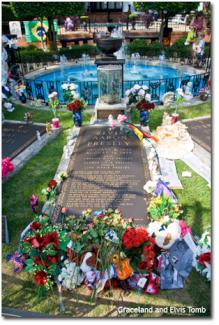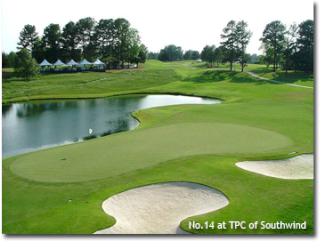Featured Golf News
Hitting the Greens in the Home of the Blues

There is plenty to do in Memphis, a place where the Mississippi River meets the southwestern corner of Tennessee. And if city leaders have anything to say about it, golf should be added to the stout lineup of local attractions.
Memphis is primarily known for its music - it's the Home of the Blues, the Birthplace of Rock and Roll and the site of Graceland, residence and final resting place of Elvis Presley. The city is also famous as the home base for Federal Express, for its contribution to the civil rights movement, its barbeque, for the fourth largest pyramid in the world, and a group of ducks that swim in a hotel fountain.
A recent visit to the region showed how golf in this area has become another draw to a municipality that considers itself the "entertainment center of the Mid-South."
Memphis has eight city-owned courses, five of which are 18-hole layouts and three with nine holes. Every one of the courses has been in play since at least the mid-1960s, with four of the tracks built before 1932. The city's Park Services - which has jurisdiction over the municipal courses - has led to renovations of three of the city's courses over the past six years.
The region has a handful of daily-fee courses and a select, but prestigious, group of private tracks, including Spring Creek Ranch (located about 30 miles east of Memphis in Collierville) - rated one of the top courses in the state, Windyke Country Club (with 36 holes), Memphis National Golf Club (another 36) and Irene Golf and Country Club.
We were lucky enough to play two of the Mid-South's finest courses while in Memphis: the private Ridgeway Country Club and the private/resort TPC at Southwind track, home of the PGA Tour's Stanford St. Jude Championship. If these two courses are any indication of the rest of the golf offerings in the area, Memphis should be considered a "must-play" destination.

Testy Southwind Exudes Southern Charm
TPC at Southwind's championship layout serves as the centerpiece of the PGA Tour's only private golf club in Tennessee, and the gated community around the course in southeast Memphis boasts some grand homes. But don't get distracted. This track is festooned with 94 sand bunkers and 10 water hazards, so be sure to bring your "A" game to Southwind.
The course, designed by Ron Prichard, with PGA Tour professionals Hubert Green and Fuzzy Zoeller lending their expertise as consultants, stretches across 240 acres of Tennessee countryside. Each of the 18 holes was meticulously crafted by Prichard to balance playability, strategy and challenge, all with stunning beauty. The result is a compelling test of golf that exhilarates, confounds, inspires and delights.
"The first thing that comes to mind is the variety of the holes and how they can be difficult for pros and yet fun for the membership," Zoeller said of his co-design. "There's a lot of character to the golf course."
For the professionals and those looking to get beat up from the tips, TPC at Southwind plays 7,244 yards to a par of 70, with a rating of 75.9 and a slope of 138. Most players will tackle Southwind from the regular tees, which offer plenty of challenge at 6,509 yards and par 71, with ratings of 72.9 and 131.Tee boxes and fairways on the course are Zoysia, with the rough and greens Bermuda.
Many of Southwind's more ballyhooed holes are on its back nine, but there are several holes on the front that demand your attention. The 554-yard, par-5 third makes you work the ball to the left or right of a huge tree in the middle of the fairway about 90 yards off the green.
No. 5 plays as a 485-yard par-4 from the tournament tees. Better yet, head to the players' tee - which are normally ahead of the tournament tees - and play the hole as a 499-yard par-5; neither option is easy because of the hole's sharp dogleg-right shape and its narrow green protected by sunken bunkers on its left flank.
The sixth (at 445 yards) and the seventh (482) are long par-4s that require great shot-making skills and length to reach the putting surface in regulation. No. 9 - another long par-4, is a dogleg-right with a narrow landing area that sets the tone for the back side and leaves you looking for a little help to recover a few lost shots.
The 10th hole at TPC at Southwind is not much help. The 465-yard monster par-4 brings water and sand into play on both your tee shot and approach. The 165-yard, par-3 11th, considered an abbreviated version of the famous island-green 17th at TPC Sawgrass, involves a short-iron shot over water to a small putting surface; going long is sure death.
The 231-yard, par-3 14th ranks as one of the toughest holes on tour each year. When standing on the tee you have to make the decision to go at the pin - which is often on the back-right quarter of the green - or take danger out of play. This hole requires a long-iron or wood tee shot to a narrow green protected by water along its entire right side. The green contains a large undulation in its midsection.
The 461-yard, par-4 18th at Southwind serves as a spectacular finish to a great round of golf. The tee shot must be played alongside a water hazard that protects the left side of the fairway. The hazard then continues to the left of the smallish green and causes any golfer to think twice before aiming their approach shot at the flagstick.
Opened in March 1988 and host to the Stanford St. Jude Championship since 1989, TPC at Southwind was one of first golf courses in Tennessee to earn Audubon Cooperative Sanctuary Program certification; it was recently recertified. The track was built on a dairy farm; two grain silos and a windmill still stand on the property. As part of the 2004-05 renovation, 22 acres of the course were converted to native areas, which enabled the conservation of water, fuel and chemicals, while enhancing wildlife habitat.
In addition to the course, the club boasts a practice facility, various dining options and the personalized service and privileges synonymous with the PGA Tour's network of premier clubs. Any golfer with an afternoon to spend in Memphis owes it to themselves to get in a round at TPC at Southwind. For more information, visit http://www.tpcatsouthwind.com.
Ridgeway Proves Worth the Trip
Before deciding to visit Memphis and play golf, we knew we were going to tackle TPC at Southwind. But we also wanted to play another course while in the area and, out of sheer luck and great fortune, we were able to score a tee time at the fabulous Ridgeway Country Club in Germantown.
Ridgeway, designed by Ellis Maples and opened in 1972, has all the chops and challenges you would expect to find at one of the best courses in the country. The track plays at 6,933 yards and to a par of 71 from the longest tees, and, believe me, you won't want any more. Ridgeway's course rating is 73.6, and it has a slope of 133.
Lined by trees and slight rises and falls, with perfectly placed water hazards and sand bunkers also factoring in, Ridgeway features small, undulating putting surfaces. The layout contains Zoysia grass fairways and tees, and Champion greens.
Right out of the box at Ridgeway you know you're in for a treat. The opening hole plays away from the clubhouse as a 418-yard par-4 with a slight bend to the right. The green is guarded with three bunkers in front, making an accurate approach crucial to getting a par.
Ridgeway's third is a 219-yard, par-3 with sand-bunker-ringed surrounding green, and the fourth is a narrow 406-yard par-4 with a speed slot on the right side of the fairway - catch a big drive and you'll have a short chip in.
No. 5 is 420-yard dogleg-right that will tempt you to cut the corner; the reward is great, but tall oaks will knock down all but the best of efforts. The seventh hole at Ridgeway is a long and straight 520-yard par-5 that starts narrow, opens up, and then tightens nearer the green. Only the straightest of long hitters have a chance at eagle.
The eighth (Ridgeway's No. 1 handicap hole) is a punishing 464-yard par-4. Out-of-bounds on the left will penalize a hooked drive, but there is a fairway bunker there to catch many wild shots. Its big green is protected by three strategically-placed bunkers.
No. 11, Ridgeway's longest offering, boasts a huge fairway. On this 565-yarder, you need to be aware of the water on your approach shot and a tough back-left pin placement. The 12th has a tight landing area made even tougher by its 462-yard length. Don't go left on this par-4 as trees will stymie a shot to the green. Big right-handed hitters with a draw will benefit from a down-slope in the landing area.
If you're long off the tee, try to hit over the mammoth fairway bunkers along the left of No. 15, a 439-yard, dogleg-left par-4. If able to go deep on the drive, it's only a wedge in. But hitting your approach short will challenge you with a lengthy bunker shot.
Most great golf courses are defined by their finishing holes, and the closing trio at Ridgeway is a group to remember. The 16th - a 465-yard, par-4 - tests you with water along the right, woods left and sand all around the green. A lake is situated 288 yards from the tips, so big hitters may get wet - this is a real thinker's hole as the No. 2 handicap offering on the track.
While No. 16 beats you up with length and danger, the par-3 17th calls for pinpoint accuracy. Playing 178 yards, the true island green looks like a postage stamp as you stand on the tee. A large putting surface awaits, but its slopes are not for the faint of heart.
Ridgeway's closer is a fitting end. The course's signature hole - with the oak tree featured on Ridgeway's logo protecting the green - plays to 550 yards. It sports a lake that enters play both off the tee and on the second shot. The bravest will try for this par-5 in two. But what's the rush - take all three shots to enjoy and linger over the experience at the private Ridgeway Country Club.
For more details, visit http://www.ridgewaycountryclub.com.

Steve Habel is an Austin, Texas-based journalist and Cybergolf's Southwest Correspondent. Since 1990, he has traveled around the globe covering news, business and sports assignments for various news bureaus, newspapers, magazines and websites. He also contributes to Business District magazine in Austin as managing editor and is the Texas football beat writer and a contributing editor for Horns Illustrated, the Austin-based magazine for University of Texas sports. Habel writes a weekly golf column for The River Cities Tribune in Marble Falls, Texas, and is a member of the Texas Golf Writers' Association.
Story Options
 |
Print this Story |
